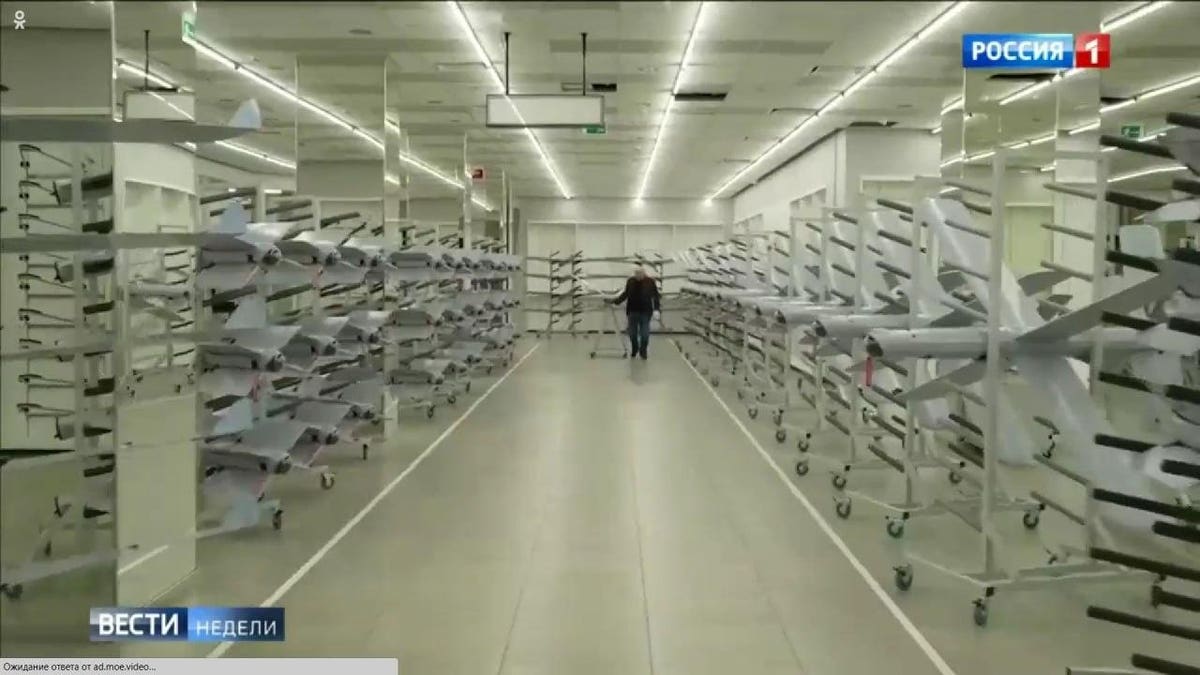Russia is stepping up production of one of its most effective weapons, the Lancet-3 loitering munition or kamikaze drone. Television news footage shows a massive new facility with hundreds of the weapons being manufactured as the makers claim that production is being tripled. The news item also responded to an earlier Forbes piece about the Lancet’s on-board intelligence and revealed details of a new swarming attack version.
The news item on the state-controlled Rossiya 1 (“Russia 1”) channel showed what appeared to be a modern production facility which has been set up in a former shopping mall in just eight weeks. Alexander Zakharov, leading Lancet production, comments that he needs a Segway to get around the facility because it is so large. The Lancet is made by ZALA Aero Group, a subsidiary of the Kalashnikov Concern.
The Lancet-3 has proven lethally effective in Ukraine. It has an eight-foot wingspan, weighs about 35 pounds and cruises at about 70 mph with a range of 25 miles and a highly effective anti-tank warhead: videos show Lancets apparently taking out Leopard 2 tanks and a wide range of other targets including artillery, anti-aircraft systems, personnel carriers, command posts. While there is a question over just what the hit rate is – misses may greatly outnumber hits – a large number of Lancets could do a lot of damage. Defense thinktank RUSI notes that the Lancet is becoming become Russia’s preferred weapon for counter-battery strikes, possibly for its ability to find and target artillery which has moved away from its firing position.
Whether the mall scenes show an actual working production facility or a mock-up for the cameras is difficult to tell — Russia invented the Potemkin village, a showy facade created to disguise an embarrassing truth. Zakharov says that they are using state-of-the-art CNC machines, welding robots and laser cutting tools but these are not in evidence: what we get are staff in white coats moving partially-assembled lancets from racks to tables. And the hundreds of body shells seen in the video are the simplest and cheapest part of a drone to make — you build a working drone body out of sticks, or, in Ukraine, duct tape – the electronics are more difficult, and, as Forbes reported, the Lancet relies on an imported U.S.-made Jetson TX2 chip for its brains.
As we reported, this chip is designed to provide AI capability, but Zakharov appears to dispute the use of the term ‘artificial intelligence’ applied to the Lancet.
“There is no AI in this drone, just algorithms and decision making,” says Zakharov, calling the Lancet a “software-defined weapon.” (Translation via Samuel Bendett).
This seems to be a matter of terminology rather than capability. Decision-making algorithms are often seen as a form artificial intelligence, as Zachary Kallenborn used the term in the original article. But Zakharov does not seem to think that the neural network technology enabled by the TX2 counts as AI. He does not seem to deny that the chip is used, or that the Lancet has a level of autonomous decision-making capability, though it is not clear whether this extends to identifying and selecting its own targets — yet.
The current Lancet-3 is known as Prodict-52; its successor, Product-53 is shown in the video and certainly does appear to have a high level of autonomy. Rather than being fired singly, the 53 comes in a quadruple launcher. This has prompted a redesign of the Lancet’s wings. While retaining their distinct cruciform shape, the wings now fold flat to fit in the container, a configuration similar to the American Switchblade 300. More importantly, and the Lancets fly together as a group and carry out co-operative attacks. When a group of targets is identified the Lancets pick one each and attack simultaneously. (This may fit the technical description of a drone swarm).
“Such claims should be scrutinized carefully given how much conflicting data is out there,” Samuel Bendett, an expert Russian drones and adviser to both the CNA and CNAS, told Forbes. He notes that Russian social media channels had already made some rather specific claims about the Lancet’s neural network capability and its autonomous guidance.
In addition, the Product 53 is only shown in animations, with no live footage, which may be a clue that it is still vaporware.
Bendett says that the actual capability of Lancet-3s will only be determined by close examination of the models that fall into Ukrainian hands. Images posted social media of a crashed Lancet-3 showed the Jetson TX2; this has already been superseded and NVIDIA
NVDA
DIA
Zakharov says that the new production facility has been funded by State money, although it is not clear that any new order has been placed. The difficulties of the Russian procurement system appeared to have caused delays with getting Lancet-3s out, which is why they only started appearing in numbers several months after the invasion. Bendett quotes publicly-available Russian sources saying that the lancet costs about 3 million roubles or $35,000.
Meanwhile Russian volunteer groups are producing small FPV attack drones by the hundred, and the Russians continue to bombard Ukraine with larger Iranian-made Shahed loitering munitions – at least 25 of them in the Southern region on the night of 17th July according to Anton Gerashchenko, Advisor to the Minister of Internal Affairs. After a poor start, Russia is now embracing a new type of warfare with different sized of low-cost kamikazes for short, medium and longer ranges in what is increasingly becoming a war of drones. Whether Russia’s reality can match Zakharov’s claims is another matter.
Read the full article here





